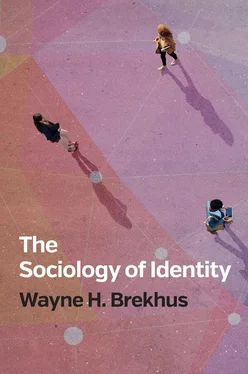In this book I analyze the broad range of categories around which we construct identities. Although identity is diverse in its forms, the latter are often similar in their organization and in their general analytic qualities. I therefore bring together the insights of symbolic interactionist ethnographic studies on particular types of identity with the analytic advantages of a cognitive sociological approach that identifies general patterns through comparisons across specific forms.
Cognitive Sociology Meets Symbolic Interactionism: Social Pattern Analysis of Identity Authenticity, Multidimensionality, and Mobility
To synthesize a wide range of sociological conceptions of identity and to compare identity across the many substantive forms and purposes in which it expresses itself, I follow Eviatar Zerubavel’s (2007) social pattern analysis —a concept-driven cognitive sociology approach to general sociological theorizing. This kind of formal sociological theorizing is characterized by lack of interest in singularity and in isolating unique phenomena and by a concern with cross-case, cross-level, and cross-phenomenal comparisons. Zerubavel (forthcoming) argues that, in contrast to more substantively oriented types of scholarship, such as historical or descriptive ethnographic work, a formal sociological analysis transcends the specific and the concrete in order to focus on general and abstract commonalities. Social pattern analysis is a concept-driven sociology that illuminates sensitizing concepts (see Zerubavel 2007). I combine this general formal theoretical approach, however, with specific, empirically interesting micro-sociological cases of identity enactments and performances studied by symbolic interactionist ethnographers. I draw significantly on ethnographic researchers who study specific identities, roles, and groups, because the concepts they develop in specific settings such as punk authenticity (Force 2009), or black cultural capital (Carter 2003), or protean racial identities (Rockquemore and Brunsma 2002) are analytically applicable to other kinds of settings and generalizable to other kinds of cases. Applying social pattern analysis to punk authenticity and black cultural capital, for instance, allows us to extend insights from these specific types to other kinds of authenticities and cultural capital. Here I apply the general theoretical concerns of social pattern analysis to theoretically focused ethnographies that are analytically portable, speak to larger macro-level issues, and build upon other ethnographies and research studies (see Fine 2003).
The three major, sensitizing concepts labeled in this book “identity authenticity,” “identity multidimensionality,” and “identity mobility,” which I use to frame an understanding of the sociology of identities, are general theoretical concepts that demonstrate analytic commonalities and generic formal similarities across very different kinds of identity. These concepts are important for understanding the power dimensions of identity and the role of identity constructions in producing and reproducing inequalities, marginality, and privilege. In the course of exploring these three properties of identity, other analytic concepts will also be highlighted and discussed in connection to their broader relevance to the sociology of identity. Those analytic concepts have developed in the specific contexts of sociological ethnographies and identity literatures, but they apply across different types of identity.
Bringing together theoretical traditions to analyze the sociology of identity is an ambitious task, particularly given that the term “identity” is used in multiple ways by analysts. Rather than provide a single definition of identity, my goal is to present identity and identification in the pluralistic ways that they are employed by social actors and described by social analysts and to explain the interactional and social boundary work that identity does. This means that the text will move between relatively thin, weak forms of identification and thick, strong forms of identity, between the conscious use of categorial identities as strategic resources and the unconscious expression of them as a tacit presentation that does work (even when what it does goes largely unacknowledged), and between expressions of self-identity and group identity. The concepts of authenticity, multidimensionality, and mobility will be explored through a cognitive sociological lens, illustrating how these concepts relate to one another and to the ways in which we interactionally perform identity. Organization around these themes and around the key concepts that cut across theoretical perspectives in identity studies provides an overview designed to spark new insights and fresh ideas for exploring the stakes of identity. An emphasis on how these themes relate among themselves and to social inequalities further frames why identity is an important topic for sociological study.
Why Study Identity in Sociology?
Why should sociologists study identity? Answering this question relates both to why they should concern themselves with something that is already extensively studied in psychology and to why they should examine the seemingly personal issue of identity rather than the big structural questions that drive much of the sociological research.
People often think of identity as a very personal, unique, and individual thing. Given individualist notions of identity and our cultural tendency to think in terms of personal identities first, psychologists have typically been regarded as the identity specialists. Just as economists study the economy and political scientists study politics, psychologists are well suited to studying human personalities and an individual’s sense of self. Sociologists have a significant role to play, however, as identities are fundamentally social. We construct, negotiate, and narrate our selves in social networks and cultural contexts. Identities have important consequences for how we live our lives and whom we include in or exclude from our social networks. Identities shift and change as we move from one setting to the next; we respond to the cultural influences and cultural audiences of different social and geographic sites of performance. The salience of competing attributes changes across settings and across the life course according to our experiences and the people we interact with. Identities are heavily tied to social power and to privilege and marginalization. Understanding identity therefore requires examining the social complexity of identities in their multiple social forms and in the varied social and cultural uses they are put to.
Sociologists often study big-picture aggregate issues and large-scale social problems. The massive issues of social inequality, globalization, migration, environment and environmental change, education, political systems, and organizations are central to the concerns of contemporary sociologists. On the surface, identity can appear like an interesting micro-sociological issue, but one that may not be integral to the really big issues of our time. This is a perception perhaps shaped in part by earlier, more individualist strands of symbolic interactionist theories of identity and by the initial political stance of the Society for the Study of Symbolic Interaction, which presented its interests in the local and interactional as a challenge to mainstream sociology and to its wider emphases. While the study of identity has traditionally attracted micro-level sociologists of everyday life (in the tradition of Erving Goffman) and symbolic interactionists (in the traditions of Mead, Blumer, and Cooley), identity is not limited to those interested in self-presentation and symbolic interaction. Identity is also relevant for many of the big issues.
Читать дальше












